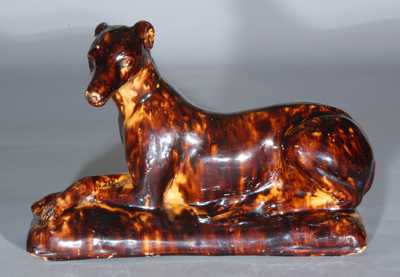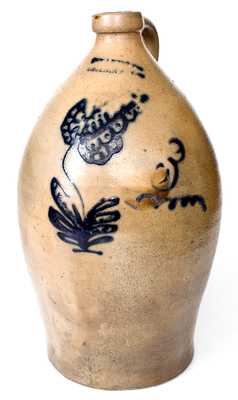Exceedingly Rare and Important Six-Gallon Lidded Stoneware Presentation Jar with Cobalt Floral Decoration and 1874 Dates, Incised on Underside "January th / 1 1874 / Made by Solomon Bell / for Tillie Bell / Waynesboro, Pa," Stamped "JOHN BELL / WAYNESBORO'," 1874, large-sized, ovoid jar with squared rim and extruded lug handles, the surface dipped in a whitish slip and decorated on the front and reverse with an elaborate brushed design of three tulips with long, spotted stamens emanating from a leafy stem. Further decorated above with a sinuous vine with graduated leaves. Dated "1874" below each handle. Cobalt highlights to handle terminals. Incised on underside in fine script, ""January the / 1 1874 / Made by Solomon Bell / for Tillie Bell / Waynesboro / Pa." Both sides of the jar include a brushed cobalt "T," one in block script and the other in cursive, for the jar's owner, Tillie Bell. John Bell's maker's mark is impressed under one handle, below a hand-incised "6." The jar includes its original tulip-decorated lid, also impressed with John Bell maker's mark on the underside. Few examples of American stoneware tell a story as this jar does. It was made by Strasburg, Virginia, potter Solomon Bell on New Year's Day 1874 while visiting his brother, John, in Waynesboro. He inscribed the piece as a gift for his niece, Tillie Bell, the youngest daughter of John and Mary Elizabeth Bell to survive into adulthood. As an acknowledgement of the pottery where it was made, Solomon has stamped the jar with his brother's maker's mark. Born on January 14, 1838, Matilda Catharine "Tillie" Bell lived her whole life in the family home on the southwest corner of West Main Street, near her father's shop. Like her father, she taught Sunday school at the local Lutheran church. A published pastel-on-paper portrait of John Bell, now in the collection of the Renfrew Museum in Waynesboro, Pennsylvania, was sketched by her. As Tillie's birthday was less than two weeks after the jar's date, the piece may have been made as a birthday present from her Uncle Solomon. A comparison of Solomon Bell's signature on his few surviving hand-signed works with that on this jar confirms that this piece was inscribed by him, as opposed to another potter at the shop. Bearing the signature of Solomon Bell and stamp of John Bell, this jar stands as an important collaboration between the Shenandoah Valley region's two most famous potters. It is one of only two examples of pottery known bearing the name of both brothers, the other being a two-gallon jar with simpler decoration, made on the same day by Solomon for a second niece, Annie Bell, currently on display at the Renfrew Museum in Waynesboro, Pennsylvania. Potted in an ovoid form with heavy, squared rim, the jar in this auction stylistically relates to those produced by Solomon during his formative years in Winchester and first two decades in Strasburg. The jar's decoration is outstanding, featuring a desirable long-petaled variant of John Bell's classic spotted tulip motif, as well as highly unusual vining above. The contrast of the cobalt against the whitish, slip-coated ground is among the best that we have seen on an example of stoneware produced by any member of the Bell family. Additionally, measuring six gallons in capacity, this jar presents itself as an impressive, standalone object. Circa 1840, as a twenty-three year old, Solomon spent time working with John in Waynesboro, a period when a number of plaster pottery molds were made. Some were brought back with Solomon to the pottery of his father, Peter Bell, in Winchester, where he was employed at the time and mastering his craft. One surviving mold bears the inscription, "Solomon Bell / Waynesboro." This jar, made at his brother's now-thriving shop thirty-four years later, is a testament to the Bell brothers' life-long dedication to the potter's craft. Solomon Bell is regarded as the definitive figure of the Shenandoah Valley style. From his birth in 1817 until his death in 1882, he witnessed and participated in the shift of Valley pottery production from small redware shops in Hagerstown to the larger operations of Strasburg, which supplied the greater area with a wide variety of wheel-thrown and molded stoneware and redware. He is credited with producing one of the great American folk sculptures, the large redware figure of a lion, which has become a symbol of the Museum of Early Southern Decorative Arts and is also displayed on the cover of H.E. Comstock's authoritative book, The Pottery of the Shenandoah Valley Region. Other masterworks include a stoneware water cooler with profuse applied, brushed, and stamped decoration, which has resided in the collection of the Philadelphia Museum of Art since the early 20th century, and a pedestal-based redware water cooler with Daniel-in-the-Lions-Den motif owned by the Museum of the Shenandoah Valley in Winchester, Virginia. Only a very small number of pieces made by or attributed to Solomon Bell include a hand-incised inscription. Among these are a few molded redware whippets and spaniels and a cobalt-decorated stoneware trivet that bear the potter's name and/or date. This jar is noteworthy as one of the most heavily-inscribed pieces made by this legendary Southern potter. Combining rich family history, grand size, and strong decorative appeal, this work is easily regarded as one of the most important examples of Bell family stoneware known. Literature: For more information on this jar, see Kille, "Bell Family Presentation Jar," Ceramics in America 2005. Jar in excellent condition with a 2 1/2" line from rim and a tiny nick to interior of rim. Lid with chips and two short surface lines from edge, not visible on underside and likely in-the-firing. The jar's remarkable condition suggests it was a treasured heirloom within the Bell family. H (including lid) 17".




























